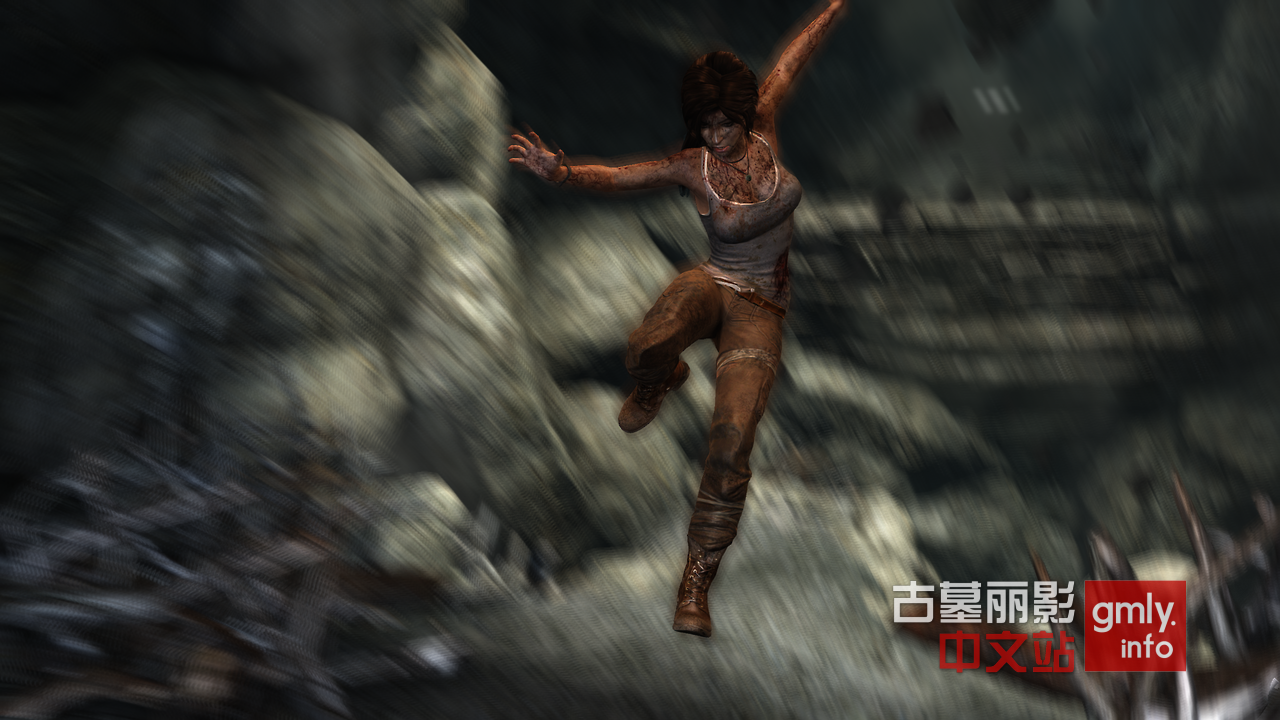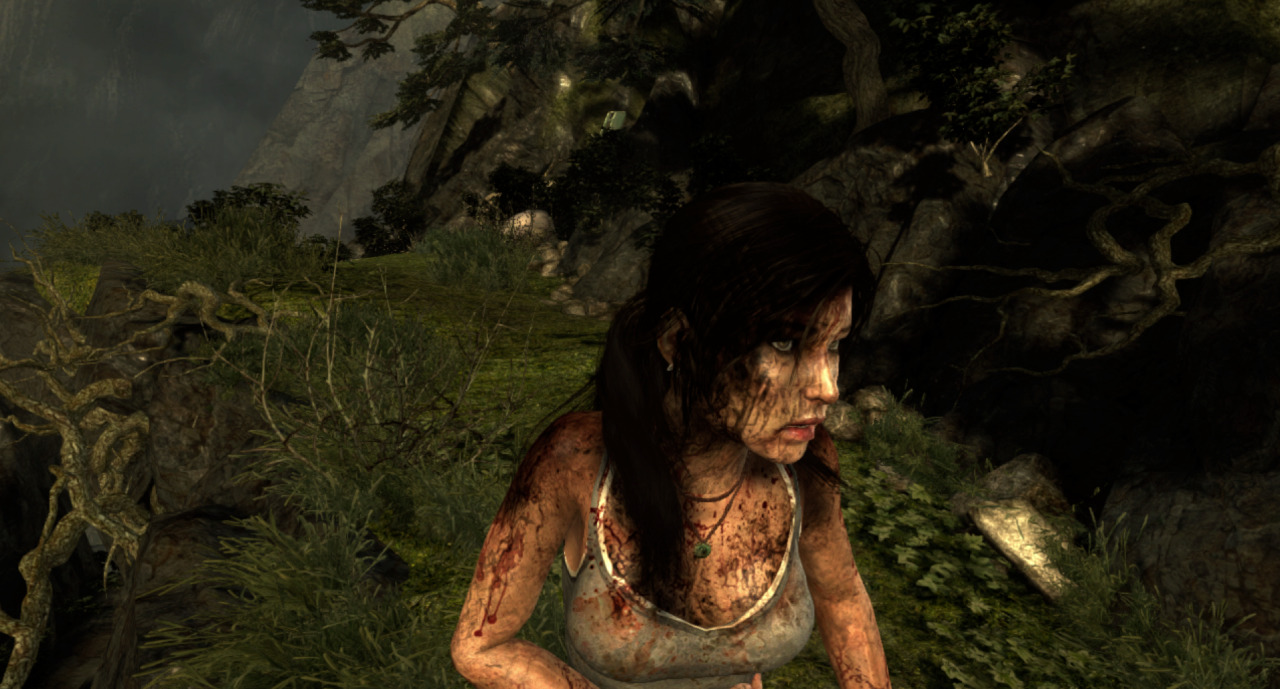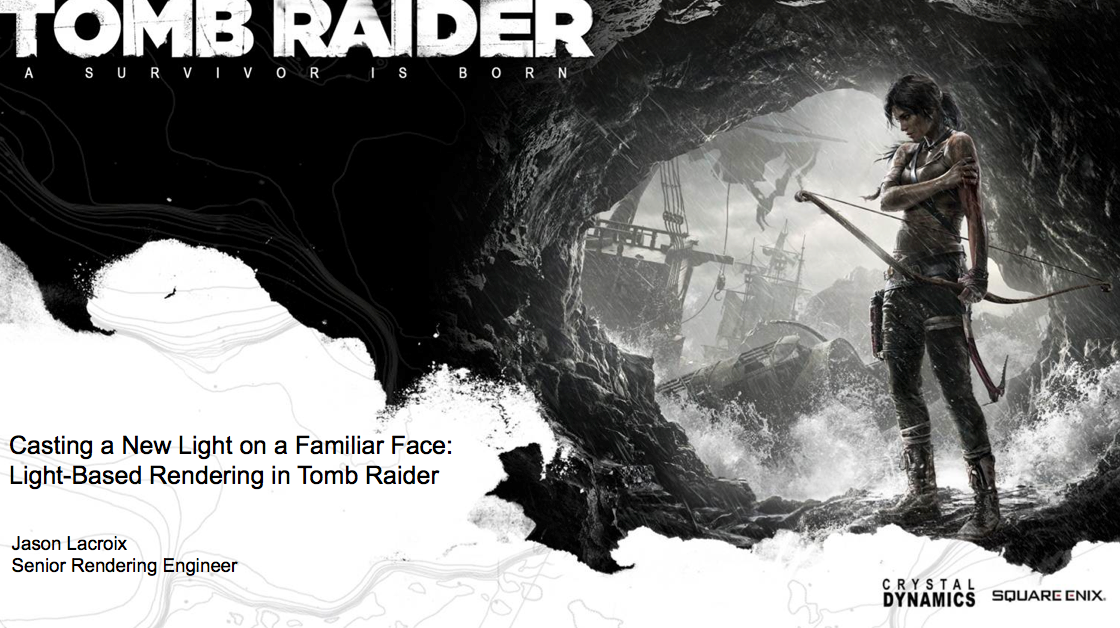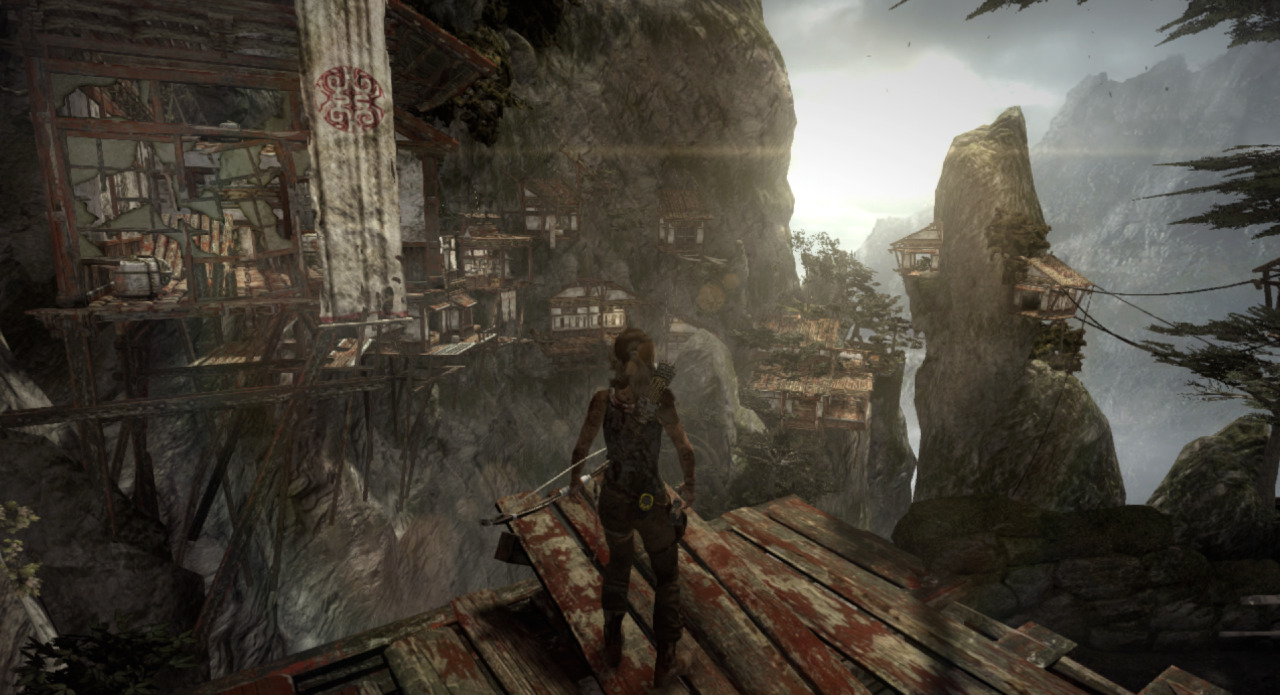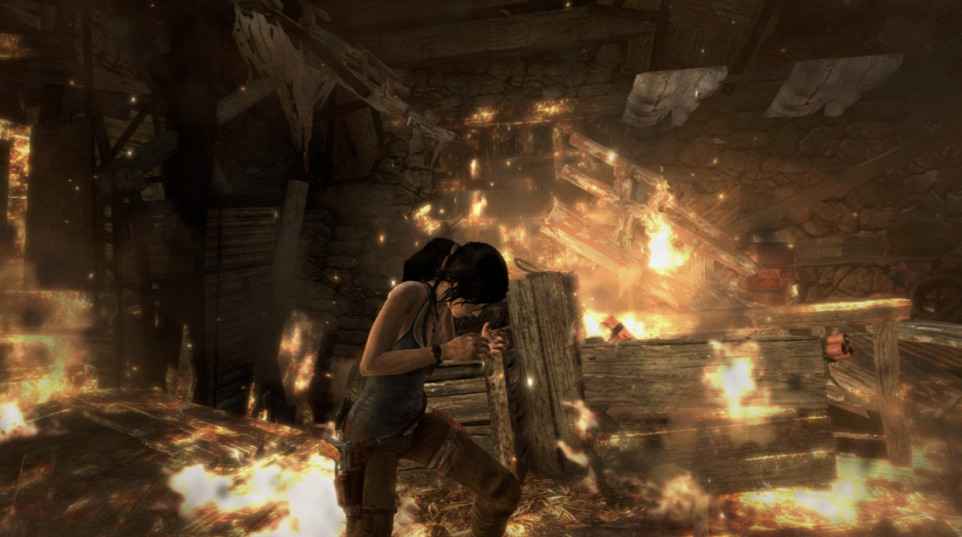在2013年游戏开发者大会上,晶体动力介绍了游戏开发中的一些内幕,古墓丽影官方博客上陆续更新了相关内容,古墓丽影中文站在2013年4月对文章主要内容的节选和编译,并非全文翻译,原文查看可以前往官方博客。[1]
关卡编辑工具 Horizon
古墓丽影新作沿用了古墓丽影三部曲的游戏开发引擎Crystal,但游戏最终效果已经大大不同。游戏开发者大会上,晶体动力演示了他们的开发工具Horizon。
Horizon是晶体动力用于构建游戏世界的工具,其突出优势被晶体归纳为五点:
- 物件放置:允许开发者在环境中放置山峰、丘陵、弹药、建筑、动物等等,并在数字世界中对其进行拖放、旋转、变更大小等操作。Horizon中的工具具备了更高的画质和更及时的响应,为设计师带来很大的便利。在上面这个视频里,展示了在早期的海洋部分中如何放置物件并修正它们。
- 同时编辑:Horizon的这一特性允许很多人同时编辑同一个关卡。Horizon允许用户将关卡“切片”,每个片段都能分配给各自的设计师或绘图师,当他们完成各自的工作,就能将自己的成果提交,让所有的人都能看到。“切片”的依据并不一定是地形,一个片段可以是峭壁的一部分,可以是一整幢建筑,也可以是指定区域的光照效果。
- 部件构建:包括了两种模式——Monolithic和Modular。前者是在三部曲中所运用,分层次来组件游戏环境,首先构建起单一的环境,然后通过多道工序将它进一步细化。后者则是这次的《古墓丽影》中所采用的流程,将需要构建的环境拆分成各个单元,由设计师针对各自的单元来进行设计,它允许很多设计师同时对同一个区域展开工作,比起前者更为高效和快捷。
- 可视脚本:这是游戏引擎中新加入的功能,叫做Action Graph。以前,设计师编写脚本以控制动作的触发或者敌人的行动,而Action Graph则提供了更为直观的编辑方式。上面的视频中,2分50秒处就是一个演示。
- 即时编辑:Horizon允许设计师进行即时编辑,用户能够在编辑关卡的同时立刻查看到相应的效果。虽然这一特性在以前的编辑器中同样具备,但在Horizon里却得到了大大的强化。在上面的视频中,对直升飞机的编辑就是个例子,把盒子加上去以后,可以马上看到它们在游戏中的表现。
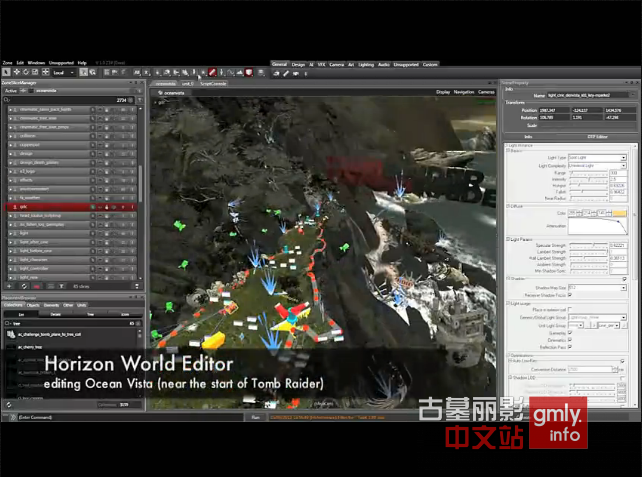
| 原文:[GDC RECAP] Horizon and Beyond: A Look into Tomb Raider’s Tools |
|---|
| Now that Tomb Raider is on the market, we’re eager to show fans some of the impressive technology under the hood. A handful of Crystal Dynamics’ staffers recently attended the annual Game Developer’s Conference in San Francisco, presenting on Tomb Raider’s system design, tools, camera, and more. I’ve culled down their presentation into a slightly more digestible format to give you some insider information on making the game!
Next up to bat is Jason Yao, our Senior Tools Software Engineer/Dessert Chef Hobbyist speaking to Tomb Raider’s toolsets. Having the right tool for the job is important to all crafts, and game design is no exception. As Jason puts it – “You need AAA tools and tech to make a AAA game.” That’s where Horizon comes in. What’s Horizon? Horizon is the world builder that functions within Foundation, the Crystal Engine. Horizon’s specialty is building large worlds that support efficient art and design workflow, modular construction, multi-user and real-time editing. Essentially, Horizon allows the team to build the most complex and largest levels achieved yet at Crystal Dynamics. Development on Horizon began about four years ago, with a team of seven committed to the project. The focus was to create a world and object editor with familiar features to other 3D editors, allowing for increased productivity and quick iteration. The tool upgrade was necessary as the previous level editor proved to be a bit outdated for our ambitious Tomb Raider reboot, and certainly harder to use. While there are dozens of features and talking points the engine team would gladly dive into, Jason broke down the top five boasting points for Horizon below. You can see the tools in action above for a clearer understanding of how they have been implemented. 1) Placement Tools: Placement tools are exactly what they sound like – a set of tools that allow you to put items into an environment like mountains, hills, ammo, buildings, and wildlife. You can scale, translate, and rotate them in a digital world. The tools in Horizon have a higher level of polish and responsiveness – a really important factor that keep artists and designers happy. Affinity and ease of use yields better work and faster iteration. In the video above you can see Jason using the placement tools in one of the earlier playable section of the game – the Ocean Vista. Jason selects a cherry tree from the placement browser and proceeds to translate, rotate, and scale it until he’s satisfied. He also illustrates how you can snap objects to a predetermined grid, line, or vertex, as well conform placement to a surface. Different visualization modes, such as wireframe or shaded, also aid with seeing where to place objects. 2) Concurrent Editing: Concurrent editing is another big win for Horizon, allowing one or many, many people to work on the same level at the same time. While our previous world-editing tool allowed for some simultaneous authoring, it was not granular enough. Horizon allows users to “slice” up a level so that each slice can then be claimed by a designer or artist. When they are done, they submit their slice changes for everyone to see. Boundaries for slices aren’t determined only by geography – although you can choose to do so if desired. A slice can be part of a cliff, an entire building structure, or even all of the lighting effects in a given area. This is why Horizon is so powerful, because it gives significant flexibility in what a designer or artist can check out and work on. Previously areas had to be checked out by discipline or workflow – meaning one artist, one editor, and one scripter could work at a time. 3) Modular Construction: To understand this perk of Horizon, we’ve got to define modular versus monolithic workflows.The team switched from monolithic construction to modular construction for Tomb Raider, as they needed to build more pieces in less time. Taking the modular approach gave the designers a library of pieces and parts to choose and reuse from whenever they needed to populate a new space. This allowed for the largest environments ever achieved at Crystal, and facilitated easy duplicating, swapping and variant creation for objects. This approach does run a risk of looking less organic due to reusing assets, but the art and design teams were very conscious of this challenge and worked to ensure everything felt unique. 4) Visual Scripting: Visual scripting was a popular and totally new addition to the game engine. It is called Action Graph. Prior to implementing Action Graph, designers would type out scripts for triggering actions or controlling enemy behavior. Action Graph allows for a more intuitive and visual system similar to flow charts, although it still can get quite complex. Designers naturally gravitate to it because it’s easier to prototype and orchestrate happenings in the game world, such as controlling waves of enemies to triggering cinematic events. You can see a bit of the visual scripting via action graph around the 2:50 mark of the video above. 5) Live Edit: Last, but certainly not least is Horizon’s ability to live edit. Essentially, live editing gives users the ability to modify something and immediately see the effects in game. This feature existed in our previous world-building tool, but the upgrade in Horizon provides much more versatility. One of the perks of live edit is iterating and seeing your changes in the game right away. You can move mesh, lights, tune physics, and adjust the damage on weapons before fully committing to it. You can see an example of this in the video above as Jason plays around with physics between a pair of helicopters by dropping in boxes between the rotary blades. As boxes are added to the field, Jason can see in real time how they’d react in the game. A top five list certainly doesn’t do Horizon and Foundation’s successes and scope justice, but it gives a good taste of some of the AAA tools and engine we’ve got at work in the studio. Did you miss our other GDC recaps? Senior Systems Designer Jonathan Hamel talked about Emotional Synchronization in Tomb Raider, while Senior Rendering Engineer Jason Lacroix debuted a pair of panels talking to TressFX and Light-Based Rendering. Keep an eye out for a discussion on Tomb Raider’s dynamic camera next week! |
三大支柱
古墓丽影新作的核心是“生存&动作”,其三大支柱分别是劳拉、探索、战斗。每一个支柱都由很多游戏系统支撑。随着游戏开发的推进,团队开始致力于“情绪同步”,让劳拉的情绪状态对玩家产生感染力,并使之成为故事叙述的一部分。

战斗
首先是掩体。在最初的设计里并没有安排掩体系统,毕竟这与古墓丽影以往的特性并不相符。但是,随着游戏开发的推进,团队发现,如果仅仅是让劳拉在环境中简单的后退和射击,会产生一种被环境排挤出去的感觉,而不是成为它的一部分。加上早期的敌人设计也偏向了恐怖风格,使得游戏更像是一款生存恐怖游戏,而不是生存动作游戏。在后来的设计中,敌人被安排为由人类组成的索拉瑞教派,这样可以让敌人表现得更为智能,包括实施自我防护。但如果敌人也能够自我防护,劳拉没道理不这么做。而固定掩体也不适合劳拉,她不是金刚,娇小的她在对战时需要战术和谋略。因此,流动性的掩体系统诞生了,当劳拉靠近了一个可作为掩体的物件时,如果有敌人在附近,她就能使用这个掩体,但掩体的不稳固迫使她需要在作战时不停地移动。
其次是近战。团队起初一直反对近战的加入,因为担心会破坏游戏体验。但又意识到,对于一款以生存元素为核心的游戏来说,近战又是在弹尽粮绝时所必须的技能。因此,近战还是被加入了游戏,但一直未能确定其形式,直到将注意力放到劳拉的装备上。但如果近战显得过分的暴力或者个人英雄主义,又将破坏游戏的情绪传达。暗杀和闪避的加入,帮助了角色在近战中仍然保持了弱小和聪敏的形象。

劳拉
首先是装备方面。团队参考了大量的生存小说和现实故事,并决定引入攀爬斧作为劳拉穿行的必备工具。劳拉像前几作一样光靠手脚就能在各种环境下腾挪跳跃的超人能力,显然不适合新劳拉的设定。为了让攀爬斧能够在游戏中获得准确的定位,就需要创建一个数字的互动系统,让游戏传递出现实感。撬杆和曲柄要求玩家同步按键,以打开一个容器。点燃可燃物也同样需要一个“同步”过程,先向可燃物伸出火把让它慢慢燃起,然后冒烟,最后彻底点着。如果玩家停止了动作,可燃物将会冷却。

其次是技能方面。游戏中引入的类似RPG游戏的升级系统,使得劳拉作为一名年轻女子释放潜能的过程得以充分展现。技能的分支也让玩家能够选择适合其个人风格的游戏方式。最初,这二三十项技能被分为三大类:资源收集、探索穿行、战斗。但这个安排行不通。穿行技能的升级拖了游戏的后腿,让玩家难以判断跳跃的距离。而更大的挑战仍然是来自“情绪同步”,如果劳拉上一秒还对一个壮汉一箭穿喉,下一秒又变得弱不禁风,显然不对味。于是技能系统被重新设计,直到剧情中的劳拉已经做好了相应的准备,玩家才能解锁更高阶的技能。团队总共设计了35项技能,但在游戏里只放入了24项。其他有一些显得没有必要,也有一些融入了其他的技能里。
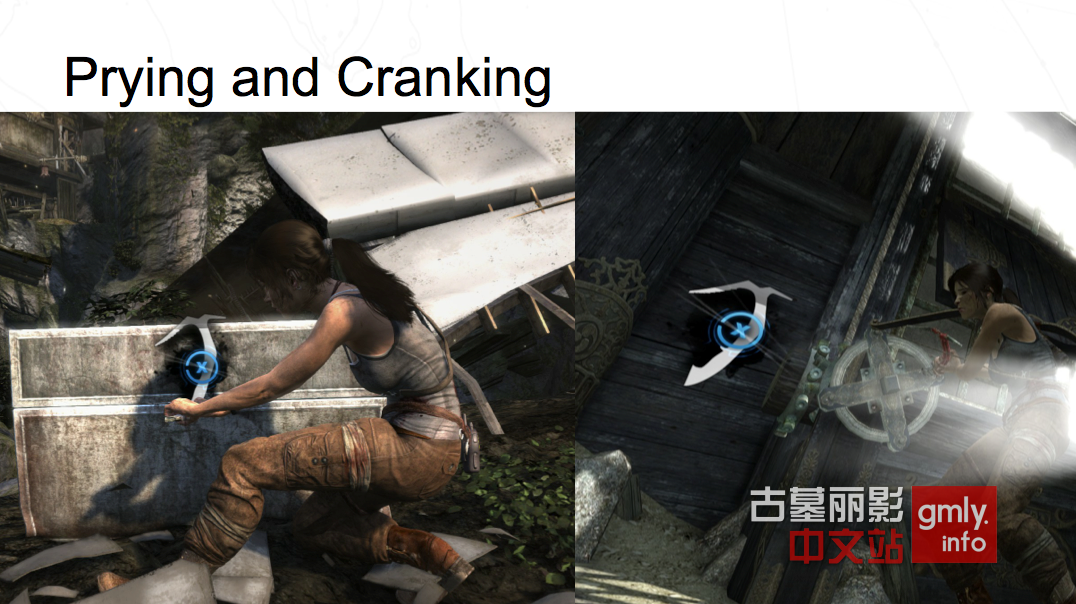
探索
首先是空中调整。允许玩家在劳拉跳起时还能调整她的落点,这是游戏开发早期就决定加入的特性。这让劳拉与玩家的操作保持了同步性,而不是相反。
其次是营地系统。游戏中加入了很多收集要素,以鼓励玩家进行探索。但要让玩家在一个线性进程中重返故地去搜寻遗漏的物品,却并不是很容易的事情。团队决定加入营地系统,让玩家能够在各区域快速跳转。但如果在一些剧情的关键点仍然让玩家跳来跳去,无疑会破坏故事体验,而与此同时,技能和武器的升级很可能又是必要的。因此,游戏中加入了两种营地,一种是日间营地,另一种是快速移动营地。前者不允许玩家快速跳转,只能进行武器和技能的升级。另一方面,营地让劳拉有机会休息、探索,或者稍稍从故事主线中脱离一会儿。

以上仅仅是《古墓丽影》的“情绪同步”上的一部分特性。达到这个目标并不容易,团队付出了大量的时间和精力,基于玩家的反馈来设计出这些系统,以保障玩家所能获得的游戏体验。
| 原文:[GDC RECAP] Emotional Synchronization and the Croft of Systems Design |
|---|
| [GDC RECAP] Emotional Synchronization and the Croft of Systems Design
Now that Tomb Raider is out and about, we’re eager to show fans some of the impressive technology under the game’s hood. A handful of Crystal Dynamics’ staffers recently attended the annual Game Developer’s Conference in San Francisco, presenting on Tomb Raider’s system design, tools, camera, and more. I’ve culled down their presentations into a slightly more digestible format to give you some insider information on making the game! If you missed our first two features, check out Jason Lacroix’s talk on TressFX and light-based rendering. Next up to bat is Jonathan Hamel, our Senior Systems Designer and part-time children’s book writer, speaking to systems design and emotional synchronization in Tomb Raider. So what is emotional synchronization? In Tomb Raider, emotional synchronization was used as a benchmark to measure if narrative design and gameplay systems aligned, making the player experience more meaningful as a result. It was decided very early on that Tomb Raider would be built upon three gameplay pillars in the “Survival Action” genre. Those three pillars are:
Each of the above is comprised of a diverse roster of gameplay systems used to support the overall experience. For example, combat encompasses ranged, melee, and stealth systems, as well as a fluid cover and weapon upgrades. All of these systems had to work in tandem to present a believable experience featuring a young woman evolving from a rookie to a seasoned adventurer. To achieve this, the systems had to hold a greater purpose – to be bigger than the sum of their parts. Jonathan’s job was to make these systems meaningful in the greater context of the game. As development on Tomb Raider progressed, Jonathan and the team discovered something interesting. When the player’s emotional state reflected that of Lara’s perceived emotional state (thus, achieving emotional synchronization), playtesters felt they were taking part in a meaningful journey rather than playing around with a collection of features. Simply put, when Lara and the player’s emotional states overlapped, it made for a better game. As with most entertainment, emotion emerges as a result of narrative. In linear media such as books or movies, however, we’re passive to unfolding events. Game narratives have the bonus layer of interactivity, presenting an extra challenge when it comes to synchronizing feelings between the character and the player. The gameplay mechanics will either support the narrative and enhance the experience, or jar you out of it. If the player felt out of step with Lara, the bubble would burst and the meaningfulness of her journey would crumble. This truth had a dramatic impact on the systems design in Tomb Raider. How exactly? Jonathan’s presentation provided several potent examples. COMBAT: FLUID COVER First up, combat. Early in development Tomb Raider didn’t have a cover system. It didn’t fit with the personality of past Tomb Raider games, and at that point combat was thought to be mostly ranged versus melee, similar to Resident Evil or Dead Space. As the game evolved, however, the team found that the players would simply retreat through the environment to shoot, and subsequently felt detached from the environment rather than a part of it. Combined with the early concepts for enemies, the tone was too far away from survival action. It felt more like survival horror – not what the team wanted. As the game evolved, enemy design settled on humans in the form of Solarii cultists, and having (relatively) sane humans rushing an armed player for melee attacks didn’t make sense. Human antagonists also necessitated more intelligence from enemies, including fine-tuning squad behavior, self-preservation systems, and so on. Left as is, combat felt like a shooting gallery. Lara wouldn’t just hang back and pop off headshots. She’d be fast and nimble. She’d run and jump and use her traversal training to avoid enemies. With enemies taking cover, it made sense for Lara to do the same. A sticky cover system like in Gears of War didn’t feel right for Lara. She needed a tactical advantage to make up for her smaller size. Lara’s strength is in her agility. As such, the fluid cover system was born. If Lara is near cover and enemies are present, she’ll use it. The scramble became a defensive move to quickly get from point to point of cover. In the early stages of combat design, the player felt disconnected from Lara and the world. Eventually both the fiction and gameplay pushed towards a ranged player versus ranged enemy combat styling, resulting in the development of a fluid cover mechanic that aided in overall emotional synchronization of the player. COMBAT: MELEE With all this talk about ranged combat, why introduce melee at all? Jonathan says the team actually resisted melee for a long time. Melee is especially tricky because if it’s overpowered in a ranged game it will break the experience. The team recognized that in a game featuring visceral survival elements, melee was thematically important and a way to recover from running out of ammo. As such, the decision was made to include melee, but the exact implementation was up in the air. The team tested shoving enemies back to shooting range, contextual-only melee moves, and even an underpowered system with purchasable upgrades. Time and time again, playtesters kept their focus on an important piece of Lara’s equipment. They wanted the ability to use Lara’s axe against foes, and it seemed rational that she’d use it as a defensive tool. The challenge became straddling the line between melee feeling too violent, or too heroic, and as a result breaking synchronization. Stealth kills and dodging to open windows of vulnerability helped maintain a scrappy and resourceful feel to melee combat. The implementation of ranged combat, melee combat, and the fluid cover system resonated with playtesters. They felt like Lara, desperately using all their skills to escape a situation by the skin of their teeth. Whereas one dominant combat strategy would have broken the bubble of emotional synchronization, the dynamic pacing resulting from alternating between cover-based ranged combat and melee combat actually fortified it. SMART RESOURCEFUL LARA: GEAR-BASED INTERACTIONS Next up, the brains of the game – a smart and resourceful Lara Croft. The most interesting synchronization stories center on survival skills, salvage, and gear-based interactions on Yamatai. During the concept phase of Tomb Raider, Jonathan immersed himself in survival fiction and non-fiction, including Gary Paulson’s children’s novel, Hatchet. The tale stressed a person’s dependence on tools when stranded in the wild. The team was sold on the idea of a climbing axe being used to gate traversal, as it wouldn’t feel right for an inexperienced Lara Croft to jam her fingers and toes into tiny cracks like in past games. Jonathan proposed that an upgrade ramp would help the player feel that Lara was investing in and dependent on similar gear items. In terms of the application, somatic mimesis was key – creating a digital interaction that feels like a real world counterpart through the game’s controls. Prying and cranking replicated this by mashing buttons to simulate the effort needed to open a container. The same was true for igniting objects. Holding down a button for a set period of time would see an object smolder, then emit smoke, and then eventually ignite. If the player stopped applying heat, the object would naturally cool off. Some ideas of somatic mimesis didn’t make the cut, though, such as experimentation with using the sticks to emulate Lara feeling a fallen enemy’s clothing for ammo. In Jonathan’s own words “it was a terrible idea.” SMART RESOURCEFUL LARA: SURVIVAL SKILLS & SALVAGE Jonathan next explained that survival skills via a light RPG system was a clear way to mirror the narrative of a young woman unlocking her full potential. That being said, fine-tuning the unlocks was important to keeping the action adventure pacing, rather than turning into a full-blown RPG. The skills also had to offer sufficient enough choice to allow the player to express their individual play style. At first 20-30 skills were created and divvied up in three pillars: resourcefulness, traversal, and combat. This approach didn’t work. Traversal upgrades essentially broke the game by making it difficult for the player to quickly evaluate successful jumping distances. The biggest challenge, though, was once again emotional synchronization – there was a disconnect if Lara could stab a guy in the throat one moment, and then revert to being an unsure young woman the next narrative moment. To combat this a skill gating system was set up to prevent players from buying specific abilities until Lara was ready for them. The system required the player to purchase enough skills at a specific level to unlock the next tier. This option gave the player choice, while keeping Lara from becoming too tough, too soon. Overall the team built around 35 skills, but only 24 made it in the game. Some seemed gratuitous for even a hardened Lara. Others we merged into a single skill so that there wouldn’t be too much difference between the more and less valuable-feeling skills. TRAVERSAL AND EXPLORATION: AIR STEERING Not everything was a hard-won lesson in the development of Tomb Raider. Air steering was a decision made early on that turned out to be a gem. It ultimately gave the player a feeling of agency and again aided in synchronizing the player to Lara. This time, however, it was Lara synchronizing to the player’s actions rather than vice versa, as she would adapt to movements and adjustments mid-air. TRAVERSAL AND EXPLORATION: FAST TRAVEL & COLLECTIBLES Collectables are great for encouraging fans to explore every inch of a world, as well as giving them a benchmark for success against peers. In Tomb Raider incentivizing those collectibles was easy enough – creating sets of items begged for completion, and displaying the full catalog of collectibles from the start motivated players further. The method of allowing retraversal to find these collectibles, however, proved difficult. Environmental destruction prevented linear backtracking to nab missing collectibles in several key areas. The team decided to implement a base camp system, which would allow the player to fast travel backwards to anywhere they had previously rested. This created a conundrum, though. Fast traveling away during a key plot point would disconnect the player from Lara’s current plight, but upgrading tools or skills could be crucial to progression in the narrative. Two types of camps were needed as a result. Day camps are slightly less permanent looking, and allow for upgrading weapons and unlocking skills, but not fast traveling. Base camps on the other hand give Lara the chance to take a break, explore, and deviate from the narrative. The above are only a handful of gameplay considerations that encourage emotional synchronization in Tomb Raider. Achieving this alignment isn’t easy, as systems need to be finely tuned with an engaging story and reward mechanics to ensure they’re not working against each other. As Jonathan illustrated, the team spent an incredible amount of time iterating on design based upon playtest feedback so to ensure the player felt one with Lara, not at odds with her. |
镜头运用
在以往的古墓丽影中,镜头一直是一个弱点,而当镜头运用得非常完美时,它却往往不被注意,因此镜头的重要性经常被低估。
在这次的《古墓丽影》中,首席镜头设计师Remi及其所领导的团队希望镜头不但运作良好,还要能够帮助玩家融入游戏,在情感上更深入地与角色相融合。而实现这一目标的途径,就是这一套独特的系统以及诸多方面的仔细考量。

Remi在GDC所做的陈述中,为团队的工作罗列了详细的清单,向我们展示了镜头的运用何以对于游戏的整体体验是如此重要。
- 讲述故事:动态镜头能够为玩家提供相关信息,而无需角色对此做任何介绍。例如,当受伤的劳拉来到贫民窟附近时,镜头收缩到直升机处,展示出了她的目的地。
- 展现气氛:镜头是游戏灵魂的窗户。光照、特效、音响等等都在气氛烘托中扮演了重要角色,而镜头则展现了劳拉在环境中的运动过程。它的存在不为人感知,但其作用却是举足轻重。
- 传递情绪:一个运作良好的镜头,能够更好地传递出情感。例如在劳拉猎杀第一头鹿的时候,一个针对劳拉脸部的紧凑的俯视角度展示出了她对这一狩猎牺牲品的歉意和愧疚。类似的,近景和特写往往能够强调一种紧张的场面,比如劳拉失去武器却被逼上绝境时。
- 促进互动:在解谜时镜头也可以发挥作用,通过追踪特定物件,它能够暗示出解谜的方略和可能产生的效果。在坚忍号甲板上的镜头是一个很好的例子,当时劳拉需要拉下重物砸开甲板去解救艾力克斯。
- 引导玩家:通过聚焦到特别的路径,镜头可以引导玩家前进,或者能够对于不确定的行动所可能导致的结果提供额外的信息。
- 引荐角色和介绍场景:当出现新角色时,镜头能够带给玩家对他或她的第一印象。在到达新地点时也与之类似。还记得劳拉跌跌撞撞来到索拉瑞堡垒时的场景吗?镜头从摇摇欲坠的建筑慢慢地向上移动到山顶的古代神庙,展示了这个区域的规模和气氛。

以上总结是针对一个勤勉工作的镜头系统所能达成的效果,但对于《古墓丽影》来说这些还不够。本作中的镜头还要表现出被拉下神坛的“人类”主角的现实感,因此Remi的团队还为他们的工作列出了如下目标:
- 纪录片风格:团队希望能够让镜头展示出一种现场感,就像玩家是在劳拉的身边一同冒险。
- 生命力:在纪录片风格上更进一步,镜头还需要很有生命力,根据情况而变化而采取不同的表现策略。
- 个人化:目标是让镜头展示出劳拉的视角。不是第一人称,但却能够展示出劳拉的感受和情绪。
- 物理化:镜头同样需要有物理感,有重量,并能够对这个游戏世界做出反馈。例如在爆炸后镜头的剧烈晃动。
- 仿真化:团队也渴望在镜头上模拟出雨水、血滴、透视等效果,以传达出环境的真实感。
为了保证目标得以实现,团队建立起了最终的镜头运用准则:
- 活跃:当镜头对于主角的行动同步互动时,游戏会变得更为迷人。例如,在尝试打开一扇门的时候,镜头逐步地收缩,而在门被撬开的一瞬间立刻拉回。
- 贴近:一个更靠近角色的镜头会变得更有感染力,能够引起玩家的共鸣,并促进对主人公的角色认同。在游戏开始,劳拉在拾荒者巢穴内涉水而行时,你感觉到了那种幽闭空间下的恐惧感了吗?
- 精巧:一个精巧的镜头在每个形势下都具有独特的表现,从而让游戏中不同的时刻都显得与众不同。例如,当劳拉从拾荒者巢穴中逃出时,她需要向着光明一路往斜坡上方爬行,这个场景就具备了独有的视角。
- 动态:动态化的镜头在游戏中不断修正着距离和角度。在游戏开头,劳拉从体侧拔出铁钉时,镜头就随着她的动作而给出相应的反馈。
- 流畅:镜头的切换需要平缓自然,无缝衔接。这一机制需要不为人感知,否则会打断玩家的游戏体验。流畅的镜头帮助角色在一个更为物理化的世界里穿行,以及在不同场景之间过渡。
很多玩家都对《古墓丽影》的镜头运用津津乐道,Remi所领导的致力于镜头表现的团队,对于实现最终的镜头效果居功至伟。下面这段视频是个小小的演示,可以结合上文的介绍来观赏一下镜头的表现。
若无法播放,请检查是否开启HTML5播放器,或往B站观看:BV1Dx41137F8
| 原文:[GDC RECAP] Creating an Emotionally Engaging Camera in Tomb Raider |
|---|
| Now that Tomb Raider is on the market, we’re eager to show fans some of the impressive technology under the game’s hood. A handful of Crystal Dynamics’ staffers recently attended the annual Game Developer’s Conference in San Francisco, presenting on Tomb Raider’s system design, tools, camera, and more. I’ve culled down their presentations into a slightly more digestible format to give you some insider information on making the game!
Next up to bat is Remi Lacoste, Lead Camera Designer, speaking to retooling Tomb Raider’s camera. Camerawork is a contentious topic when it comes to Tomb Raider, being one of the notable franchise shortcomings fans struggled with in the past. The unfortunate challenge with camera design is that a team’s hard work often goes unnoticed unless something is broken. When a camera is working well, it works on a subconscious level, so the importance of a successful camera is often underestimated. In rebooting Tomb Raider, Remi and the team wanted to ensure that the camera was not only functional, but that it engaged players and helped them become more emotionally involved in the game through unique systems and stylistic considerations. Remi spearheaded this initiative through the role of Lead Camera Designer at Crystal Dynamics. What exactly does this position entail? Camera Designers are a rare species – a hybrid roll of an art designer that works to develop tools with programmers. Remi kicked off his GDC presentation with a laundry list of why carefully crafted cameras are so important to the overall gameplay experience.
The duties above are the foundation of what is expected from a hard working camera, but flair was needed to carve out a unique character for Tomb Raider. The camera had to be retooled to fit a new reality of a grounded and human protagonist, and as such Remi and the team set several stylistic goals for their work:
The above stylistic decisions helped work towards a singular goal of creating an emotionally engaging experience – something that was gripping, mesmerizing, and involved. To ensure they hit the mark, however, the team established one final set of camera criteria.
Many fans commented on how our newest Tomb Raider felt cinematic, captivating, and engaging. Remi and the camera team had a significant hand in helping to achieve this level of immersion though careful camerawork. Tune into the video above to use your newfound knowledge of camera craft to spot these techniques at work. Did you miss our other GDC recaps? Senior Systems Designer Jonathan Hamel talked about Emotional Synchronization in Tomb Raider, while Senior Rendering Engineer Jason Lacroix debuted a pair of panels talking to TressFX and Light-Based Rendering. Most recently, Jason Yao dove into Tomb Raider’s toolsets. |
头发特效

对比效果:

概念图对比
-
初始效果
-
开启 Tress FX
截图对比
-
初始效果
-
开启 Tress FX
| 原文:[GDC WEEK] A Survivor is Born: Tomb Raider on DX11 & Tress FX |
|---|
| Now that the game is out and about, we’re eager to show fans some of the impressive technology under Tomb Raider’s hood. A handful of Crystal Dynamics’ staffers are out at GDC this week, presenting on Tomb Raider’s system design, tools, camera, and more. I’ve culled down their presentations into a slightly more digestible format to give you some insider information into making the game!
Up to the plate is Jason Lacroix, our Senior Rendering Engineer/resident rock climber, speaking to how Tomb Raider takes advantage of DX11. As you guys are likely aware, the PC edition of Tomb Raider was a collaborative effort spearheaded by Nixxes, a longtime partner with our studio first established in 1999. Nixxes spent a good deal of time optimizing the PC edition of Tomb Raider, particularly when it came to tessellation technology, but the most interesting optimization was the hair simulation and rendering in TressFX. The team knew that when it came to the DX11 version of the game, they wanted to do something that would stand out. Both Nixxes and Crystal wanted to make Lara’s hair as realistic as possible, and took this opportunity to see how far they could push it. As fans often note, Lara’s hair is a massive part of her identity, and an upgraded hairstyle became a way to embellish and add life to her character. Prior to TressFX, many great contributions to the world of hair rendering had already been made, such as ATI (now AMD)’s work on Ruby Hair in 2004, Alice’s hair in Madness Returns, as well as Square Enix’s impressive tech in Agni’s Philosophy. So what makes great hair? According to Jason it is a multi-tiered approach. First, starting with a great asset is important, then running it though a great simulation to sell the illusion, in addition to anisotropic lighting to give it a realistic highlight pattern. Also, anti-aliasing to avoid jaggies, and self-shadowing to sell the illusion of multiple layers of hair. Last, there is translucency.Our goals aligned with those of our partner AMD, who had a demo in place which provided a great foundation for our efforts. In our first pass most of the AMD source code was copied into our engine. From there the team iterated through various stages of simulation and rendering, evolving the code until we got the desired results. Ultimately, the final code doesn’t stray too far from the original implementation, other than the shading and shadowing, which was done from scratch on our end. When it came to implementation, we were lucky enough to be able to take advantage of work already done by VisualWorks, the internal movie team at Square Enix who rendered our Turning Point trailer, among many other impressive accomplishments. They already had hair assets for us to use. All that had to be added was additional hair to the asset to achieve the proper amount of coverage. The VW content had 4,737 hairs used to drive rendering. You can see from the image above that this didn’t provide quite enough density. Our modified hair asset has 7,014 strands of hair, providing enough coverage. Hair strands were also duplicated with a small amount of offset to add more coverage. Meaning, the final count after duplication was 21,042 hair strands, each made up of 16 vertices.Maya allowed for further customization of said hair, per unique strand. We were able to decide if the tip was movable (such as at the end of a ponytail or bangs) and even the thickness of individual strands. Lara’s hair had to be sorted into four different groups to export properly: the bangs, the cap, the fringe by the shoulders, and the ponytail. Each group goes though the full rendering process of simulation, shadow map rendering, shading, and anti-aliasing. In regards to simulation, we had to determine what Lara’s hair looked like when running. Jumping. Rolling. What about in the wind? The team found early inspiration from Australian hurdler Michelle Jenneke, who showed us how hair moves under all of the aforementioned condition. Thanks to the nature of sports videos, the team had multiple angles, close ups, and side views of her hair’s natural movement. We also recorded some hair from the ladies at the studio. Global and local shape constraints helped to keep the hair manageable – it was our very own version of gel or mousse. The global constraints helped to preserve the hair style and initial shape, so that it would reset to the initial position after strong agitation. The local constraints were used to manage the bending and twisting forces that affect hair. Capsules on Lara would aid with collision detection with the hair as well.Simulation was unique to each of the four groups of Lara’s hair. Each determined the parameters and controlled how the hair reacted in differing states, such as wet versus dry hair. A total of seven simulation profiles were used in this capacity, including those to tell if Lara was upside down (such as in a snare trap) or “mid wet” – meaning her ponytail and fringe were under water, but not bangs and cap. Lighting Lara’s hair proved to be a challenge more than once, as this is a Tomb Raider game and we’ve got lots of locations where you are in dark, dank underground caves. This led the hair to go to a really matte black color and lose its dimensionality. In order to prevent this, the team created a virtual beauty directional light that comes in towards Lara’s head from 200 centimeters above the camera in such spaces. In doing this, the results are subtle, but the detail is important to keeping her hair realistic looking. In regards to shadows, standard shadow sampling made also had the hair looking flat, and a system had to be implemented to address it. An approximated deep shadow lookup would calculate the shadows based on the depth of the current hair strand being shaded. The further down the hair, the more shadows, meaning, the top hair have very little and look much more realistic. As you can see, upgrading Lara’s hair wasn’t a quick fix, but one well worth it. Hope you’ve enjoyed this in-depth look at TressFX! |
光照
| 原文:[GDC WEEK] Casting a New Light on a Familiar Face: Light-Based Rendering in Tomb Raider |
|---|
| Now that the game is out and about, we’re eager to show fans some of the impressive technology under Tomb Raider’s hood. A handful of Crystal Dynamics’ staffers are out at GDC this week, presenting on Tomb Raider’s system design, tools, camera, and more. I’ve culled down their presentations into a slightly more digestible format to give you some insider information into making the game!
Up to the plate is Jason Lacroix, our Senior Rendering Engineer/resident rock climber, speaking to light-based rendering in Tomb Raider. Light-based Rendering before Tomb Raider [2013] As you may know, Tomb Raider utilizes a proprietary engine, aptly named the Crystal Engine. It’s been hard at work all through Legend, Anniversary, Underworld, and Guardian of Light. That being said, it’s evolved quite drastically since it first debuted. Despite this, the engine’s lighting systems only had the capability to take advantage of forward lighting and heavy use of light maps until this project.This approach was fine for Underworld, but needed to be refined for Tomb Raider due to a shift in internal workflow. This shift moved to modular asset creation with a tool called Horizon (more on Horizon in a different presentation!) that allowed for rapid iteration, increased content creation within a limited team size, and the ability to reuse assets. For example, many assets in the scavenger hub (such as a rusty sheet of tin) were combined in unique ways to make larger structures. These sorts of instanced assets aren’t great for laying out UVS or light maps. The fact that much of Tomb Raider’s environments are also destructible or would later be set on fire caused some issues with continuing to use light maps. The last argument against light maps related to the economy of space games operate on. We knew fairly early on that size constraints were tight, and that there would likely be a deficiency. Complex materials, textures, and a massive library of set pieces meant that there wouldn’t be enough room on disk, or memory, to integrate light maps. Making a Case for Hybrid Lighting So there was the problem. What was the solution? Deferred lighting seemed the obvious answer, but the art team wasn’t convinced that we’d get the same quality results by tossing light maps out the window. They needed to be sold on the idea.The team couldn’t move forward without a unified decision, so some convincing was in order. The rendering and technical art teams were positive that they could get great results with differed lighting. A studio-wide “Pepsi Challenge” was put in place. The two teams went head to head, with the studio serving as judge in blind tests. Each team had two weeks to complete work on the same level. One would use the deferred solution; one would take advantage of light mapping. The blind challenge put the deferred lighting as the clear winner, but there was still room for some of the other lighting solutions for specific scenarios. Techniques & Features in our New Lighting Pipeline As a result we ended up moving forward with a hybrid solution. Opaque objects would use deferred lighting through an accumulation buffer, and forward lighting would be implemented when dealing with translucent objects or complex materials such as hair or water.The system takes advantage of various light types (point, directional, spot, and so on) as well as complexities (universal, fill, player) and can even be edited in real time thanks to art-driven lighting stages. For example, this lighting system allows the artist to control the intensity of light over time, by creating a curve to be applied over a specific duration. This allows for the ebb and flow of light on a surface when in close proximity to Lara’s torch. The system also allows for the application of a random offset to individual light instances, to ensure they don’t accidentally synchronize with each other. Shadowing was another complex task for the team to tackle. The lighting system supports standard projections for spotlights, and up to four splits on directional lights. There is also what we call Texture Projection Modulation, that takes into account water caustics, cloud cover, tree shadows, and so on. Making the world feel alive and real in a wide array of circumstances isn’t easy. Solving New Problems, Optimizations, and Enhancements One of the tricks with having a deferred approach to lighting for opaque objects is that we lost the ability to mask (block) out lights for things like the player. The art team really wanted to be able to light the player separately from the rest of the environment, which necessitated creating player lights, most often used in cinematics. Even with these new sets of tools, the team had a number of problems to solve, such as applying environmental effects in mass, wetness to materials, and making entire levels burn without changing the source art at all. This resulted in the creation of wet lights and fire lights. Wet lights give the illusion that water is cascading down the sides of geometry through specular reflections. Tiled normal maps are animated to control how hard it is raining, have cascades flow faster, and so on.Jason concluded his presentation by diving into optimizations: how they keep the game running at 30-60 FPS by including linear world depth targets, light bounding volumes, low-res lights, and particle lighting optimizations. I hope you’ve enjoyed this in-depth look into the lighting of Tomb Raider! |
脚注
- ↑ 由于官方博客平台在墙外,这里将原文附于每一章节后,供有兴趣的玩家参考。
